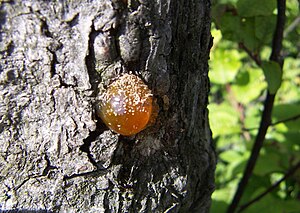Natural gum
This article needs additional citations for verification. (April 2022) |
Natural gums are polysaccharides of natural origin, capable of causing a large increase in a solution's viscosity, even at small concentrations. They are mostly botanical gums, found in the woody elements of plants or in seed coatings.
Human uses
They are used in the food industry as thickening agents, gelling agents, emulsifying agents, and stabilizers, and in other industrial adhesives, binding agents, crystal inhibitors, clarifying agents, encapsulating agents, flocculating agents, swelling agents, foam stabilizers, etc. When consumed by humans, many of these gums are fermented by the microbes that inhabit the lower gastrointestinal tract (microbiome) and may influence the ecology and functions of these microscopic communities.[1][2]
Examples
Natural gums can be classified according to their origin. They can also be classified as uncharged or ionic polymers (polyelectrolytes). Examples include (with E number food additive code):
| Source | Classification | Natural gum | E number | biological origin |
|---|---|---|---|---|
| obtained from seaweeds | Polyelectrolytes | Agar | E406 | |
| obtained from seaweeds | Polyelectrolytes | Alginic acid | E400 | |
| obtained from seaweeds | Polyelectrolytes | Sodium alginate | E401 | |
| obtained from seaweeds | Polyelectrolytes | Carrageenan | E407 | |
| obtained from non-marine botanical resources | Polyelectrolytes | Gum arabic | E414 | from the sap of Acacia trees |
| obtained from non-marine botanical resources | Polyelectrolytes | Gum ghatti | from the sap of Anogeissus trees | |
| obtained from non-marine botanical resources | Polyelectrolytes | Gum tragacanth | E413 | from the sap of Astragalus shrubs |
| obtained from non-marine botanical resources | Polyelectrolytes | Karaya gum | E416 | from the sap of Sterculia trees |
| obtained from non-marine botanical resources | Uncharged | Guar gum | E412 | from guar beans |
| obtained from non-marine botanical resources | Uncharged | Locust bean gum | E410 | from the seeds of the carob tree |
| obtained from non-marine botanical resources | Uncharged | Beta-glucan | from oat or barley bran | |
| obtained from non-marine botanical resources | Uncharged | Dammar gum | from the sap of Dipterocarpaceae trees | |
| obtained from non-marine botanical resources | Uncharged | Glucomannan | E425 | from the konjac plant |
| obtained from non-marine botanical resources | Uncharged | Psyllium seed husks | from the Plantago plant | |
| obtained from non-marine botanical resources | Uncharged | Tara gum | E417 | from the seeds of the tara tree |
| produced by bacterial fermentation | Polyelectrolytes | Gellan gum | E418 | |
| produced by bacterial fermentation | Polyelectrolytes | Xanthan gum | E415 |
References
- ^ Hehemann, Jan-Hendrik; Kelly, Amelia G.; Pudlo, Nicholas A.; Martens, Eric C.; Boraston, Alisdair B. (27 November 2012). "Bacteria of the human gut microbiome catabolize red seaweed glycans with carbohydrate-active enzyme updates from extrinsic microbes". Proceedings of the National Academy of Sciences. 109 (48): 19786–19791. doi:10.1073/pnas.1211002109.
- ^ Ostrowski, Matthew P.; La Rosa, Sabina Leanti; Kunath, Benoit J.; Robertson, Andrew; Pereira, Gabriel; Hagen, Live H.; Varghese, Neha J.; Qiu, Ling; Yao, Tianming; Flint, Gabrielle; Li, James; McDonald, Sean P.; Buttner, Duna; Pudlo, Nicholas A.; Schnizlein, Matthew K.; Young, Vincent B.; Brumer, Harry; Schmidt, Thomas M.; Terrapon, Nicolas; Lombard, Vincent; Henrissat, Bernard; Hamaker, Bruce; Eloe-Fadrosh, Emiley A.; Tripathi, Ashootosh; Pope, Phillip B.; Martens, Eric C. (April 2022). "Mechanistic insights into consumption of the food additive xanthan gum by the human gut microbiota". Nature Microbiology. 7 (4): 556–569. doi:10.1038/s41564-022-01093-0.
